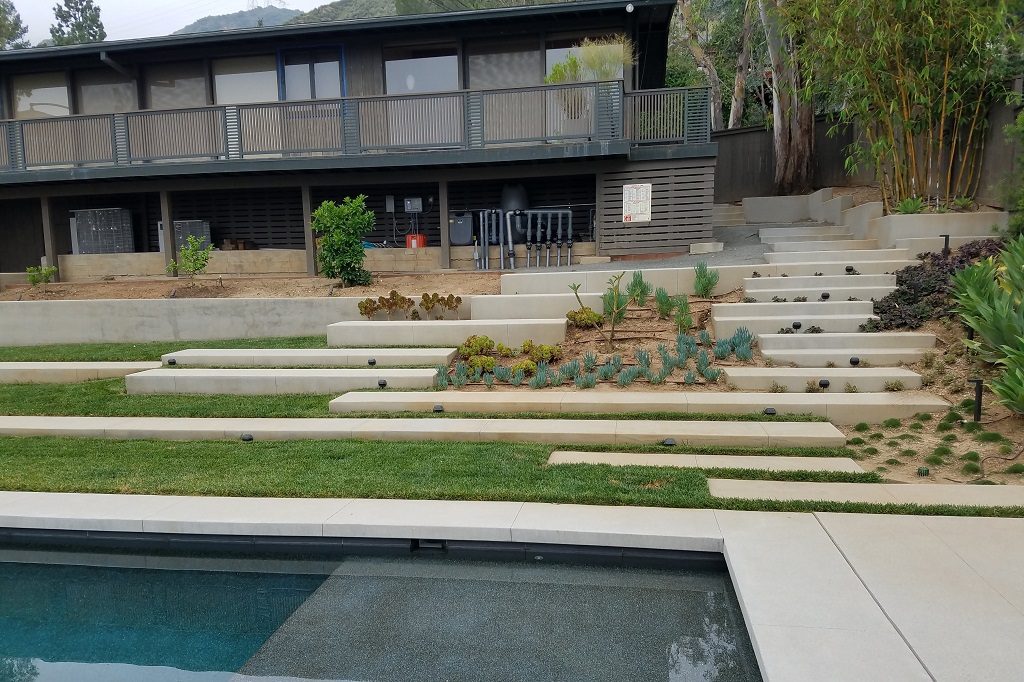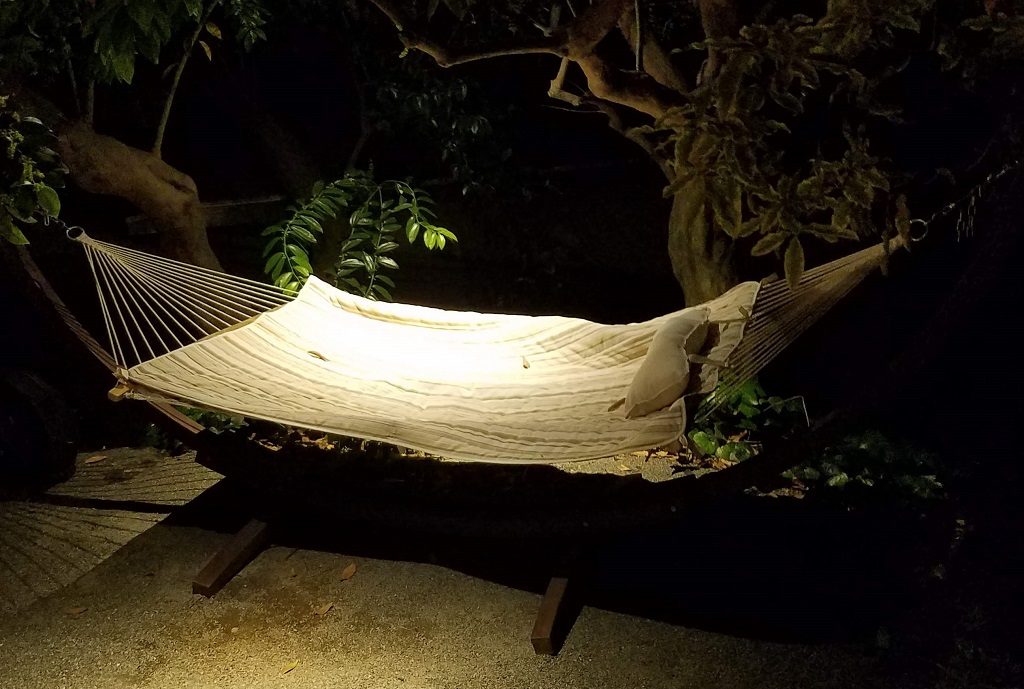A complete backyard renovation with the ability to entertain on a grand scale, was the motivation for this homeowner in the Altadena Hills. Blessed with fairly large, flat, acreage, by Los Angeles standards, he was able to construct a lap-sized pool with areas for live music entertainment and stadium seating. The area also features other gathering niches such as: a Baja bench in the pool; a large gas fire pit at the far end of the pool; and a tree-lined secluded hammock. The space is accented with drought tolerant landscaping throughout.

Purgula: What did you enjoy most about the process and/or outcome of the project?
Homeowner: The overall project was a complete backyard renovation with a large pool feature. My intent was not to simply build a pool. It was to design a backyard that could also serve as an intimate and unique live music venue. The space was fully designed starting with the pool, in such a way that it used the existing space. For this area of the Altadena Hills, flat land is difficult to come by. We took the liberty of designing the whole space cohesively upfront, instead of having it done in pieces. Key to the design process was having a strong understanding on how we like to entertain and how sections of the overall space needed to interconnect and functionally flow.

Regarding the process, I loved the creativity. I loved seeing the before and after. I loved seeing progress during construction. You know how it kind of goes and how sometimes doesn’t go. You can have creative input. I realize that’s not for everybody, but for me I like the creative side. I like construction generally, too, so it was enjoyable to see things progress. Also for me, it’s educational. So a lot of the enjoyment is that I learn. When I am doing projects of this kind I’ll watch the workers and ask a lot of questions so that I understand better. As a homeowner, I think it’s important that you can understand why stuff is the way it is. If it breaks or something happens, you know a little bit more.
Hosting our first live music event with a large crowd was especially fulfilling, as the design clearly proved itself, by simply watching how our friends intuitively experienced the space.
P: What did you enjoy least about the process or outcome of the project?
H: Dealing with the contractors – it was just a nightmare. No matter how much you think you’ve protected yourself, until you get into stuff, you just don’t know who these people are. It was not a pleasant experience. The contractor took too long and I found his business practices to be rather questionable, as I got into the project with him.
P: What was the single most challenging aspect of this renovation?
H: The biggest challenge by far was dealing with a less-than-reputable general contractor. Some of these guys, they are who they are. How do you find out about them? It’s a ratings system, and those are still really hard to get right. You have Angie’s List, but I think that the problem you have is a conflict of interest. As an example: if I gave the pool contractor a 1-star rating, do you think he would honor my warranty? Probably not. Or would I be able to enforce the warranty? He would make my life very difficult.
You are kind of in a quandary with a lot of these guys depending on what they do for you, as to how vocal you can be against them and how soon. If I needed work from him, especially the punch list items, and I did a one-star review on him anywhere, he would be difficult to work with. Even as much as he should resolve any outstanding issues, that doesn’t make people do stuff.

The CSLB (California’s Contractors State Licensing Board) recommends that you never give a contractor a review until one year after the project is signed off. I have refrained from placing any reviews, even though I realize that it is too late for those people who are starting projects now. However, I have been spreading the word within my community and network to people thinking about constructing a pool.
Another issue we had was invoicing. There was no formal invoicing process or payment schedule. He would literally walk up to me on a Friday afternoon, and say “I need $10,000”. He provided no invoice or itemization of what was completed to earn this payment. I would say “I don’t think you’re done with that, so I won’t be giving you that”.
Everything was verbal, so I would just negotiate with him. But behind the scenes, I was keeping track of all of the finances. If I had pushed him more to formalize the invoicing that would have been better. At the end of the day, I knew where I was anyway. He tried to take advantage of me from the beginning by asking for a larger down payment than what is legally allowed, but I know enough about the rules.*
Sadly, I know of another homeowner who is using this contractor to build a pool, and he took an excessive amount as a down payment. Fortunately, I signed a fixed-bid contract, so any screw ups were on the contractor.
P: What was the biggest surprise that you encountered during this project?
H: How easy it is to build an in-ground pool. It is extremely simple. To dig a large hole? It took just one day. They did catch a big tree stump, but that set them back a couple of hours, not days. However, the project took eight months to finish. Had they been here every day, a full eight hour day, it would have only taken three months, in my opinion. The actual construction is very simple. The problem was due to bad project management. I discovered that the contractor had fifteen pool constructions going on at the same time with the same crew and subcontractors.
P: Do you have another project planned in the near future?
H: The next project we have scheduled is a remodel of the hall bedroom and a full remodel of the downstairs bedroom at ground level, which faces the backyard pool area.
P: What was the biggest lesson you learned that you would like to share with other homeowners? Would you have done anything differently?
H: The most difficult aesthetic choice to make was the size of the pool – was it too big or too small? Everyone who came by during construction and everyone since, says “That’s a big pool!” And so my thought is “Are you saying that because you think that it is too big for the backyard? Or are you saying that because most pools you see are smaller?” I think it is the latter, since most pools you see are smaller because the space is not there for a larger pool. That’s fine, but I have the space, so I wanted the size to be substantive because I wanted to be able to swim a lap. I wanted the Baja Bench and I wanted the spa, but if I had made it smaller then I would not have had a large enough pool to swim laps. The actual dimension is 50 X 14.

Another issue was that the outdoor area had grading. How do you work the grade issues into the design? Do you have too many steps or too little? Do the steps get too big? How do you position it closer to the property line?

I must admit that I spent more than I wanted to on the design phase. I could have spent less on design relative to my overall budget, because I did some of the oversight myself. While I caught a lot of stuff, I did not catch everything. If I had a professional designer I would have caught virtually everything, but it would have cost an extra 15%, which I had not budgeted.
P: Would you like to share any additional comments or parting words of advice?
H: Get no fewer than three bids, bare minimum. Check out the contractors as best you can. Get some nice, rock solid contracts. After dealing with this contractor, and having heard from others, I think the pool business is a tough business and you need to be careful who you choose. Also, pools take forever. And you need to go in with that expectation. Don’t assume anything. Look at the work being done and be involved because it has big impacts if there are errors. Visit other people who have pools and attend their parties so you can observe the flow and activities of guests. Entertainment should spread out completely throughout the yard and not just in one area.



*Editor’s Note: In most states, there are contracting laws which prohibit excessive front loading of payments. In California, where this project took place, the rule is 10% of the total cost of the contract or $1,000, whichever is less. To learn more about contracts, read The Essential Elements of a Home Renovation Contract.







